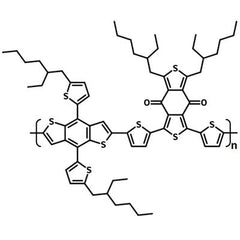PBDB-T (PCE12) Polymer Donor
High performing donor polymer for OPVs, available with batch-specific data
PBDB-T (PCE12), CAS number 1415929-80-4, is one of the highest-performing donor polymers for OPVs, having reported efficiencies exceeding 12% and a certified efficiency approaching 11%. These efficiencies were achieved when PBDB-T was used in conjunction with recently-reported non-fullerene acceptors (NFAs, including ITIC) in inverted architecture devices. These devices also exhibited excellent thermal stability, making the combination a promising candidate for the proposed 10/10 target of 10% efficiency and 10-year lifetimes.
PBDB-T (PCE12) from Ossila was used in the high-impact paper (IF 29.37), Sequentially Deposited versus Conventional Nonfullerene Organic Solar Cells: Interfacial Trap States, Vertical Stratification, and Exciton Dissociation, J. Zhang et al., Adv. Energy Mater., 1902145 (2019); DOI: 10.1002/aenm.201902145; and paper (IF 29.37), Design Rules for Polymer Blends with High Thermoelectric Performance, O. Zapata-Arteaga et al., Adv. Energy Mater., 12, 2104076 (2022); DOI: 10.1002/aenm.202104076.
PBTB-T (PCE12) is easy to process, simplifying device fabrication (using a glove box) while simultaneously providing high performance. Due to good HOMO alignment with the valence band of commonly-used perovskites, this polymer could also be potentially used as a hole-transporting material in perovskite solar cells .
Luminosyn™ PBDB-T (PCE12)
Luminosyn™ PBDB-T (PCE12) is now available.
High purity
PBDB-T is purified by Soxhlet extraction with methanol, hexane and chlorobenzene under an argon atmosphere
Batch-specific GPC data
Batch specific GPC data is always available for your thesis or publication
Large-quantity orders
Plan your experiments with confidence with polymers from the same batch
General Information
| Full name | Poly[(2,6-(4,8-bis(5-(2-ethylhexyl)thiophen-2-yl)-benzo[1,2-b:4,5-b’]dithiophene))-alt-(5,5-(1’,3’-di-2-thienyl-5’,7’-bis(2-ethylhexyl)benzo[1’,2’-c:4’,5’-c’]dithiophene-4,8-dione)] |
| Synonyms | PBDB-T, PBDTBDD |
| Chemical formula | (C68H78O2S8)n |
| CAS number | 1415929-80-4 |
| HOMO / LUMO | HOMO = -5.33 eV, LUMO = -2.92 eV [3] |
| Solubility | Chloroform and chlorobenzene |
| Processing solvent | Chlorobenzene - M1001A3, Chlorobenzene : Dichlorobenzene (1:1) - M1001A4 |
| Classification / Family |
Organic semiconducting materials, Medium band-gap polymers, Organic Photovoltaics, Polymer solar cells, Perovskite solar cells, Hole-transport layer materials, NF-PSCs, All-polymer solar cells (all-pscs). |
Chemical Structure

Device Structure(s)
The device structure of the certified devices was ITO / ZnO (30 nm) / PBDB-T:ITIC (100 nm) / MoO3 (10 nm) / Al (100 nm), with PBDB-T:ITIC solution details as follows:
- Blend ratio: 1:1,
- Concentration: 20 mg/ml,
- Solvent: Chlorobenzene
- Additive: 0.5% Diiodooctane.
MSDS Documentation
Pricing
| Batch | Quantity | Price |
| M1001A | 100 mg | £400 |
| M1001A | 250 mg | £680 |
| M1001A | 500 mg | £1250 |
| M1001A | 1 g | £2100 |
| M1001A | 2 g | £4000 |
| M1001A | 5 g / 10 g* | Please enquire |
*for 5 - 10 grams order quantity, the lead time is 4-6 weeks.
Batch details
| Batch | Mw | Mn | PDI | Stock Info |
| M1001A1 | 352,786 | 151,163 | 2.33 |
Discontinued |
| M1001A2 | 142,718 |
60,189 |
2.37 |
Discontinued |
| M1001A3 | 75,725 | 34,671 | 2.18 | Low stock |
| M1001A4 | 115,662 | 49,146 | 2.35 | In stock |
Literature and Reviews
- Energy-Level Modulation of Small-Molecule Electron Acceptors to Achieve over 12% Efficiency in Polymer Solar Cells, S. Li et al, Adv. Mater., 28, 9423–9429 (2016); DOI: 10.1002/adma.201602776.
- Ternary Polymer Solar Cells based on Two Acceptors and One Donor for Achieving 12.2% Efficiency, W. Zhao et al., Adv. Mater., 29, 1604059 (2017); DOI: 10.1002/adma.201604059.
- Fullerene-Free Polymer Solar Cells with over 11% Efficiency and Excellent Thermal Stability, W. Zhao et al., Adv. Mater., 28, 4734–4739 (2016); DOI: 10.1002/adma.201600281.
- Efficient Fullerene-Free Polymer Solar Cells Based on Alkylthio Substituted Conjugated Polymers, Q. Wang et al., J. Phys. Chem. C, 121 (9), 4825–4833 (2017); DOI: 10.1021/acs.jpcc.6b11848.
- Fine-Tuned Photoactive and Interconnection Layers for Achieving over 13% Efficiency in a Fullerene-Free Tandem Organic Solar Cell, Y. Cui et al., J. Am. Chem. Soc., 139 (21), 7302–7309 (2017); DOI: 10.1021/jacs.7b01493.

 PBDB-T MSDS sheet
PBDB-T MSDS sheet